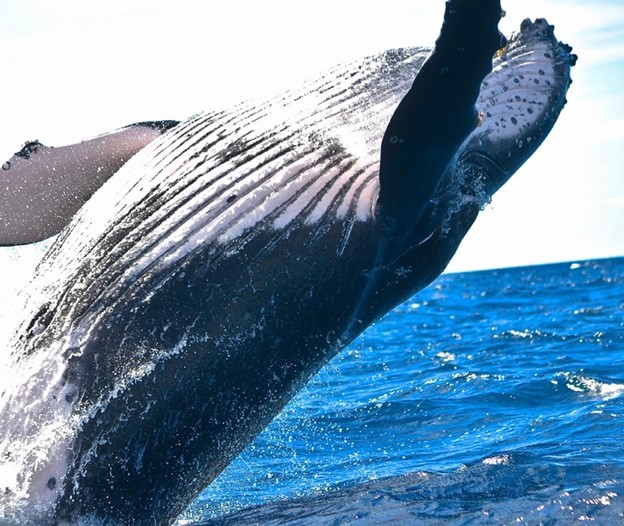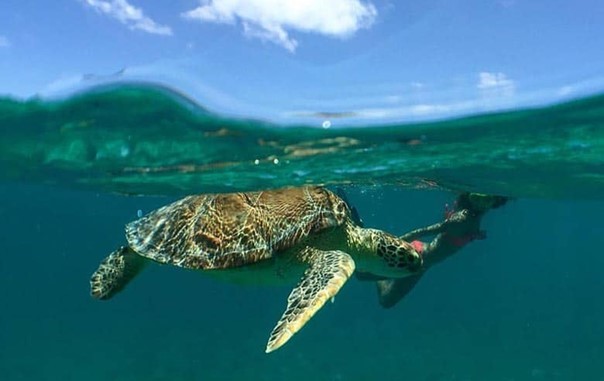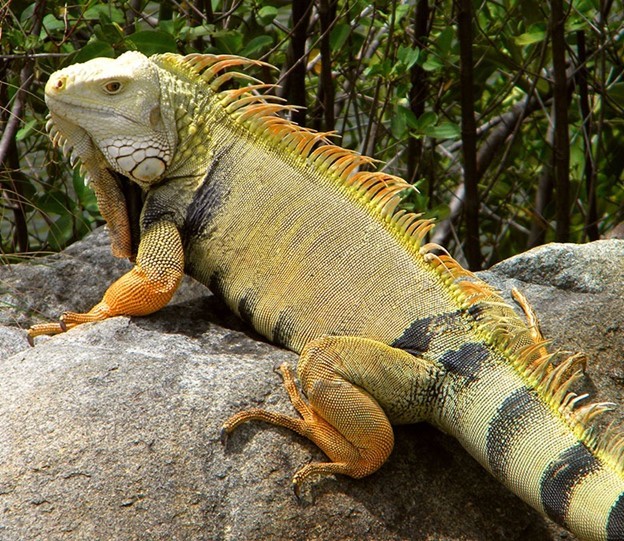
From rocky mountains and dazzling coral reefs to white-sand beaches and dense mangrove forests, stunning St. Martin has it all. This island paradise is a treasure trove of varied landscapes and filled with an assortment of unique biodiversity. On the northernmost tip of the island is the spectacular St. Martin Nature Reserve, the fusion of all the beauty the island has to offer. This incredible reserve is an ecological playground that covers over 30 square kilometres of land and 11 kilometres of coastline. Thriving in this wonderful place is a diverse range of species that will satisfy any animal enthusiast. The park takes a leadership role in the preservation of delicate wildlife and gives visitors the privilege of experiencing these beautiful creatures for generations to come. Let’s delve into the bountiful range of animals that call the St. Martin Nature Reserve home and discover where in the park you might spot them.
Sea: The Humpback Whale

Romance is in the air, or rather the sea, between December and April for humpback whale mating season. If you are lucky enough to visit St. Martin Nature Reserve at this time you may get a glimpse of these elegant creatures during their impressive migratory route. This phenomenon can be spotted all over the magnificent island of St. Martin but these gentle giants benefit from the safety of a vast protected area. In St. Martin Nature Reserve they are free from harmful fishing nets and other human interference and can thrive in peace on an open stage.
This ample space also welcomes dolphins, sperm whales, and baleen whales, but humpback whales are a favourite among marine-life enthusiasts. They are very active creatures and show off by breaching from the water and slapping the water’s surface with their fins. The largest mammal in the world is difficult to miss, so much so that you can even spot them from shore. The island offers many boating tours to help visitors get a closer look at the humpback whales’ annual reunion in Caribbean waters. Their breathtaking show of beauty and endurance is not to be missed so follow their lead and join them for a winter vacation in St. Martin.
Coral Reef: The Barracuda

The mesmerizing coral reefs of the St. Martin Nature Reserve are a colorful visual treat teeming with remarkable marine life. This plentiful habitat is a lure for the great barracuda, a long tubular fish that can grow to be 6 feet long. They are known for their ferocity and success as ambush hunters that can reach speeds of 50 kilometers an hour. Witnessing their elongated and silvery bodies shoot through the water like a bullet is an astonishing sight. Despite their efficiency and success as apex predators, any threat to humans is low and attacks are exceedingly rare. St. Martin Nature Reserve is an ideal place to spot these “tigers of the sea” where you can witness their slender bodies weave through a vibrant underwater labyrinth.
The lithe and lively barracuda is a bucket-list-worthy animal to spy while snorkelling or diving in the park. Stable water temperatures and high visibility are a guarantee year-round and the parks’ protected reservation status increases your chance of seeing the reefs active with life. Local guides are equipped to safely lead you through the delicate ecosystem and help you spot the sly and elusive barracuda.
Beach: The Leatherback Turtle

Though still not the largest animal on this list, the rare and majestic leatherback turtle is the largest species of turtle in the world and a frequent visitor to St. Martin Nature Reserve. An impressive sight to behold, these behemoth creatures dominate any landscape where you are lucky enough to spot them. These massive black and leathery turtles have existed in their current form since the age of dinosaurs but are now considered endangered. Extensive worldwide initiatives are enforced to protect them against a recent and steep decline in population. The long, protected coastline in St. Martin is the ideal pitstop for leatherbacks to find refuge during their worldwide migratory route.
Admittedly, a sighting in the water is more likely than on the beach but the elusive animal is likely to leave traces of themselves in the sand. From March to July, they leave distinct tracks when nesting on the island and occasionally lay eggs. Leatherbacks have the longest migratory path of all sea turtles, making it a true compliment that St. Martin is a stop along the way.
Land: The Green Iguana

If you don’t have the sea legs to enjoy the enchanting waters of the St. Martin Nature Reserve then you may prefer a day of hiking on its many enjoyable footpaths. Enjoy an impressive panorama of towering hills and azure tropical waters while traipsing through the colorful desert landscape. While you enjoy the view make sure you watch your step and keep an eye out for the green iguana. These playful creatures can be found scurrying around the peaks and valleys of the park and foraging for tasty local plants. Despite what their name suggests, these cold-blooded critters come in a range of colors like blue, grey, orange, and brown in order to blend into their surroundings.
No guides are necessary as the green iguana is very common but spotting them is still an exciting spectacle. When they aren’t darting between the feet of hiking tourists and sunbathing in the tropical heat, they find homes in scattered foliage around the park including hibiscus, orchid, and aloe plants. These athletic reptiles also happen to be strong swimmers so you can greet them on Pinel Island and many other islands of the park. Masters of the art of relaxation and fun, the green iguana is a perfect example of how to enjoy St. Martin Nature Reserve





